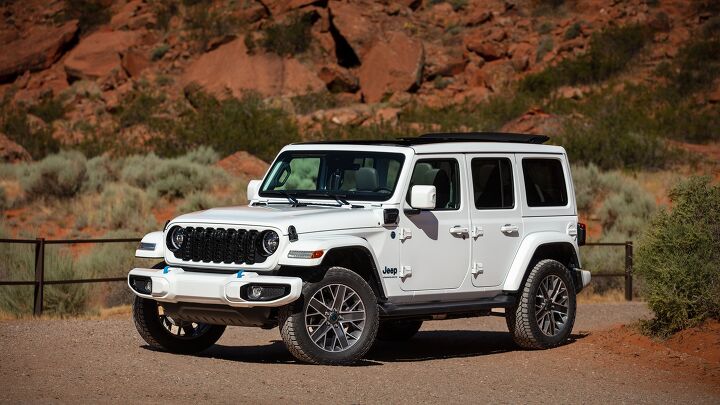Stellantis Points Blame at California for Layoff Announcement

When all else fails, blame the government. Stellantis, whose brands include Jeep, Dodge, Chrysler, and Fiat, recently announced layoffs that it blamed on the selective application of California Air Resource Board (CARB) rules. The move could impact thousands of jobs at the company’s Jeep factories in Detroit and Ohio, where it builds the Grand Cherokee, Wrangler, and Gladiator.
The announcement comes after a long drama between the automaker and the state of California. The company decided to limit allocations of its electrified vehicles to states complying with CARB regulations, which meant that non-CARB states got few if any, hybrids from the automaker. Stellantis’ issue is that the state worked with BMW, Ford, Honda, and Volkswagen in 2020 to agree to a different playbook.
That agreement judges emissions compliance across all 50 states, not just those complying with CARB standards. Stellantis believes its absence from that agreement puts it at a significant disadvantage, but it didn’t get left out unknowingly. The automaker applied to join the group but was denied over what it said was retaliation for criticizing CARB’s authority to create emissions rules. Stellantis has filed a complaint with the state over what it called an “underground regulatory scheme.”
We can debate whether or not California overstepped, but it doesn’t change the fact that Stellantis has been slower to move on EVs than other automakers despite the success of Jeep’s 4xe vehicles. The layoffs could also just as easily be related to losses from the recent UAW strikes, as other automakers – some included in the CARB agreement – have announced layoffs.
[Image: Stellantis/Jeep]
Become a TTAC insider. Get the latest news, features, TTAC takes, and everything else that gets to the truth about cars first by subscribing to our newsletter.

Chris grew up in, under, and around cars, but took the long way around to becoming an automotive writer. After a career in technology consulting and a trip through business school, Chris began writing about the automotive industry as a way to reconnect with his passion and get behind the wheel of a new car every week. He focuses on taking complex industry stories and making them digestible by any reader. Just don’t expect him to stay away from high-mileage Porsches.
More by Chris Teague
Latest Car Reviews
Read moreLatest Product Reviews
Read moreRecent Comments
- FreedMike I don't see why you can't have both EVs and conventionally powered cars.
- Zerofoo We leased a new CX-5 for my daughter when she started driving. We put nothing down and bought gap insurance. The theory was if she totaled the car, it was nothing more than a rental. If she kept the car in good shape and the car was reliable, we would, at the end of the lease, have the opportunity to buy a low-mileage 3 year old used car.
- Peter KODAK Moment
- Eliyahu Toyota has looked at the state of the world and decided that hybrids are the best fit for currently achieving environmental and regulatory goals. Their hybrid production is now across many of their models. Honda is following suit. They will both likely also produce some electric vehicles. The best path forward is likely higher fuel taxes, with some tax credit offsets for the lower tax brackets. This would encourage a move toward more fuel efficient vehicles. The US big 3 auto makers are the ones with the most to lose here-they are the late adapters-coasting on trucks.
- 28-Cars-Later Used Teslas are getting very cheap, but buying one can be risky - Ars Technica Teslas are very connected cars, and many of their convenience features are accessed via smartphone apps. But that requires that Tesla's database shows you as the car's owner, and there are plenty of reports online that transferring ownership from Hertz can take time.Unfortunately, this also leaves the car stuck in Chill driving mode (which restricts power, acceleration, and top speed) and places some car settings outside of the new owner's level of access. You also won't be able to use Tesla Superchargers while the car still shows up as belonging to Hertz. Based on forum reports, contacting Tesla directly is the way to resolve this, but it can take several days to process; longer if there's a paperwork mismatch.Once you've transferred ownership to Tesla's satisfaction, it's time to do a software reset on the car to remove the fleet version.So apparently the state maintains title but so does Tesla in a way, and they cripple some features until they feel satisfied in unlocking them to you. How long till they brick it by satellite because, reasons? But yes, rah! rah! BEV! - its not a tool of tyranny at all, honest. Edit: Comment from the Ars forum: Happy MediumArs Tribunus Militum 19y When I got to the section that stated that THE CAR WILL BE FUNCTIONALLY CRIPPLED unless you get Tesla's acceptance of you buying the car, I got incredibly infuriated. How in the hell is this going to work going forwards? Is Tesla literally going to be approving every single resale of its cars from now until the car is totaled? Jeezus, connected is one thing, but having final ownership authority in the hands of the manufacturer and not the seller/purchaser seems horrible. 28's thoughts to Happy Medium.


































Comments
Join the conversation
Stellantis deathwatch, down to 8.5% market share in US in November. That is lower than after both bankruptcies of Chrysler.
There are so many cheerleaders here for authoritarians who apply laws to parties based on the acquiescence that those parties exhibit. They'll come for you soon enough.